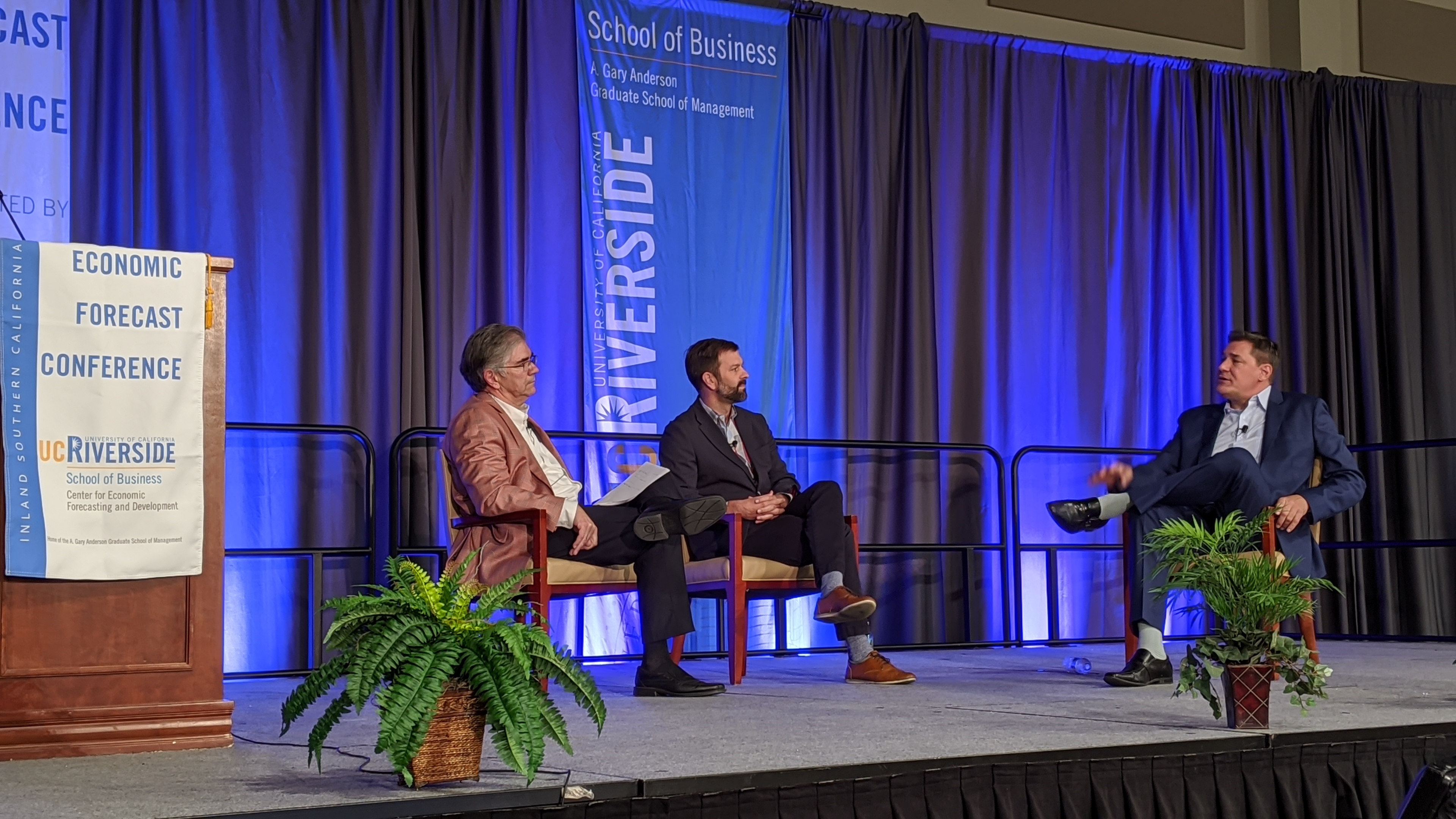Economy
The House That Wasn’t Built

UCR’s Center for Economic Forecasting says the region’s housing problem is a land use issue solvable at the local level
“It shouldn’t be about country club California. This should be a California everyone can live in,” said Christopher Thornberg, director of the UC Riverside School of Business Center for Economic Forecasting and Development, neatly summarizing the theme of the center’s 2019 annual conference.
“The House That Wasn’t Built. Housing Scarcity: The Inland Empire’s Natural Barrier to Economic Growth” was held Nov. 6 at the Riverside Convention Center. It coincided with the release of a new economic forecast for the U.S., California, and Inland Empire economies.
Thornberg said that contrary to the bleak vision of inland California embedded in some statewide economic development agendas, the Inland Empire, which consists of Riverside and San Bernardino counties, has a robust economy and the 14th largest labor force in the nation. Over the past five years the Inland Empire joined the Bay Area in fastest job growth in the state. The region’s unemployment rate of 4% is the lowest it has ever been, equaling that of Los Angeles, and it has the same income per level of educational attainment as Los Angeles and Orange counties.
However, while coastal areas boast large, highly paid professional and technical sectors, healthcare, government, and logistics dominate the Inland Empire’s economy. These jobs often require less education and fewer skills, and generally pay less than jobs in technology, finance, and educated professions that lead the coast.
Rather than regard this as an impediment to developing the kind of economy found in coastal California, Thornberg suggested the Inland Empire’s labor force and housing supply have been necessary supports to California’s growth all along and comparison to coastal areas is both methodologically unsound and unfair.
“Comparing local economies to San Jose is like comparing your health to an Olympic athlete,” Thornberg said. “The only place that looks like San Jose is San Jose.”
The housing supply, however, has not kept pace with the population, which over the past 25 years has grown three times faster than that of the coast. Apartment vacancies, for example, are at less than 4%. The region is not building enough housing, and neither are Los Angeles and Orange counties. This situation will increase regional competition for housing that is already pushing out the Inland Empire’s workforce as housing grows scarcer and rents rise. While some worry the rich are leaving California in droves, far more people at the other end of the spectrum are abandoning the state for places like Nevada and Arizona, where housing is available and affordable.
The Center for Economic Forecasting’s analysis indicates a crisis of housing supply, not affordability. California has the second lowest vacancy rate in the nation and the highest percentage of adults living with parents. Thornberg said California needs to be issuing 200,000-250,000 building permits per year to sustain a 2% job growth rate but is only doing 130,000.
“Lower-skilled workers moved inland because coastal areas put the kibosh on housing 20 years ago,” Thornberg said. “It’s like we’re saying, ‘We already kicked you out of the coastal areas; now we want to kick you out of the inland, too.’”
The center’s analysis finds the housing problem is a land use issue that needs to be solved at the local level. Thornberg said a poorly thought-out tax model exacerbates the housing crisis. Most city revenue comes from business taxes, which encourages local governments to invest in business development, not housing. If cities have to build housing, they want it to be high-end and often enact restrictive laws to prevent high-density alternatives that attract lower-income occupants, like apartment complexes.
“The decisions that need to be made to continue amazing growth in the Inland Empire are local,” said Thornberg. “We need to start having these land use conversations and making decisions.”
Read the whole story: https://news.ucr.edu/articles/2019/11/07/housing-scarcity-inland-empires-natural-barrier-economic-growth
Download the economic forecast: https://ucreconomicforecast.org/wp-content/uploads/2019/11/2019_IE_Economic_Forecast_Book_Digital.pdf
About UC Riverside
The University of California, Riverside (www.ucr.edu) is a doctoral research university, a living laboratory for groundbreaking exploration of issues critical to Inland Southern California, the state and communities around the world. Reflecting California’s diverse culture, UCR’s enrollment is more than 24,000 students. The campus opened a medical school in 2013 and has reached the heart of the Coachella Valley by way of the UCR Palm Desert Center. The campus has an annual statewide economic impact of almost $2 billion. To learn more, email news@ucr.edu.
Business
Economist Christopher Thornberg, State Treasurer Fiona Ma Headline New Forecast Conference

Coming October 5th
Economic Horizon 2024: What Lies Ahead?
The Inland Empire Regional Chamber of Commerce, in collaboration with Beacon Economics and the County of San Bernardino, is thrilled to announce that the anticipated economic forecast conference, Economic Horizon 2024: What Lies Ahead, Inland Empire? will be held October 5th from 3:30 PM to 6:30 PM at the El Prado Golf Courses in the vibrant city of Chino, California.
Esteemed economist, Dr. Christopher Thornberg will present complete outlooks for the U.S., California, and Inland Empire economies. “The Inland Empire stands at the crossroads of remarkable economic opportunities and challenges,” said Thornberg. “I’m excited to unpack the trends and shifts that will define the region’s economic landscape in the next year, and beyond.”
Known for his razor-sharp observations, and fun, energized delivery, Thornberg’s presentation will include pointed discussions about inflation, the Fed’s next move, housing markets, strengths and instabilities in the economy, and what current trends mean for the nation, state, and local region.
The conference will also be graced by the insights of California State Treasurer Fiona Ma as keynote speaker. In her words, “The strength of California’s economy is deeply interwoven with the growth trajectories of its regions. The Inland Empire, with its dynamism and resilience, is a testament to this synergy. I am honored to join ‘Economic Horizon 2024’ and share a vision where policies, partnerships, and potentials converge to elevate the Inland Empire to unprecedented economic heights.”
“This conference is a testament to the collaborative spirit of the Inland Empire and our commitment to fostering a robust, resilient economy,” said Edward Ornelas, Jr., President of the Inland Empire Regional Chamber of Commerce. “Our partnership with Beacon Economics and the County of San Bernardino aims to offer a platform for profound economic discussion, forecasting, and strategic future planning.”
Attendees can anticipate not only expert insights into the economy but also networking opportunities and a chance to connect with key business, government, and nonprofit leaders from across the region.
Full event details are available at: economy.iechamber.org
Economy
The Recession That Didn’t Happen… And Why Most Forecasters Got It Wrong
Bizz Buzz
Workforce Development Earns National Achievement Awards

#bizzbuzz
Inspired by the Board of Supervisors’ commitment to meet the needs of employers and jobseekers and foster a vibrant local economy, the San Bernardino County Workforce Development Department has been honored with eight 2023 Achievement Awards from the National Association of Counties (NACo).
Among the services and initiatives for which WDB was honored were the Rapid Response Community Resource Fair, Economic Recovery Business Outreach Program and, in partnership with the Public Defender’s office, the Record Clearing, Resource and Employment Fairs.
Thanks to strong and stable leadership and policy direction from Board of Supervisors Chair Dawn Rowe and her colleagues on the Board of Supervisors, San Bernardino County received a record-breaking 160 NACo awards this year. The awards reflect the Board’s efforts to cultivate the innovation that leads to the development of outstanding public service programs.
The NACo awards recognize the best of the best among county governments across the U.S. Nationwide, 40,000 county elected officials and 3.6 million county employees provide important services, such as caring for our physical and mental health, maintaining roads, ensuring public safety, strengthening environmental stewardship, administering elections and much more.
“The Workforce Development programs and services recognized by NACo highlight the extraordinary work being done by Workforce Development to enhance career opportunities for our residents and help businesses grow,” Rowe said.
The first Rapid Response Community Resource Fair was developed shortly after United Furniture Industries (UFI) abruptly laid off more 300 employees in the High Desert without advance notice just days before Thanksgiving 2022. When Workforce Development was alerted, staff quickly mobilized businesses and community partners to help connect those laid off to available employment opportunities, as well as various other community resources. Approximately 275 of the affected UFI employees were offered new employment opportunities as a result.
The Economic Recovery Business Outreach Program was a pilot program that tapped into the wide-reaching business network of chambers of commerce. This collaboration between WDB and various chambers of commerce throughout the county was designed to leverage the relationship between chambers and small businesses to build awareness and accessibility to Workforce Development services available to them. Outcomes as a result of this partnership include various successful services including job listings, job fairs, positions filled, and job training assistance, among others.
Perhaps the most impactful program receiving this recognition is the Record Clearing, Resource and Employment Fairs. Workforce Development and the Public Defender’s Office have partnered with businesses and community organizations to increase economic access and equity. The partnership was designed to bring critical resources directly into the community – to churches, community centers, community colleges, and America’s Job Centers – for those looking to remove barriers and increase their access to employment opportunities and other services. The Public Defender helps participants by providing expungement or record clearing services, and Workforce Development brings employers with job opportunities, all within the same location. The events have been well received and proven useful to the community, making this a long-term partnership, not only between Workforce Development and the Public Defender’s office but a long list of other community organizations that have also participated.
“Our team and board feel fortunate to be recognized for these awards,” said William Sterling, chairman of the Workforce Development Board. “The underlying factor of the programs being recognized are partnerships. We feel fortunate for our staff and the relationships developed with other departments and organizations and the impact these services have had within our communities, which is at the core of what public service is supposed to be.”
-

 Opinion1 month ago
Opinion1 month agoSurge in Unemployment Among California Youth Linked to Minimum Wage Hikes
-

 Commercial Real Estate Transactions3 weeks ago
Commercial Real Estate Transactions3 weeks agoSRS Real Estate Partners Announces Record-Breaking $6.15 Million Ground Lease Sale of a New Construction Chick-fil-A Property in Murrieta, California
-

 Health & Wellness3 weeks ago
Health & Wellness3 weeks agoBuddha Bars: A Mother’s Innovative Solution to Healthy Snacking
-
By Press Release1 week ago
California Employment Expansion Continues But Still Trails Nation









